Congratulations! Your society continues to squeeze out lumpy, furry, greasy and fragrant turds into the fresh bedding. Your government is corrupt; almost everyone in business and society is a robotic zombie; your mass culture is garbage and your jobs, jails. People are miserable inside but refuse to acknowledge it for fear of seeming weak.
On top of all of that, your future is grim as you slip further into third-world levels of filth, disorder, promiscuity, corruption, disorganization, perversity, crime and rotted infrastructure. How’s that whole modern society thing — consumerism, democracy, mass media — working out for you?
And it gets worse. The one area you could expect a refuge from this cascade of failure, heavy metal, has been turned into mentally incoherent rambling by a need to create a saleable aesthetic through using formulae for known hits. As a result, metal albums resemble salads of past influences, with no organization or principle.
This sends metal editors into a rage. Not only is our genre denying its past, but it is selling pap to teenagers during the few years of respite they should have before the adult world opens them up, sucks out their souls and minds, and replaces those with memorization, Pavlovian social response, and pleasant illusions from the TV.
Every now and then a good release pops up and the Herd immediately clamors to… deny it and consign it to obscurity. If good music appears, it makes all their bad music look as bad as it is, and then they can no longer easily rationalize their condition as garbage subjects of a trash empire.
This is why we go in search of the rare good stuff, so that it may rise above the rest as Charles Darwin laughs delightedly, and shine a light on the mediocrity of the Herd and its pretentious, artificed “individuals” as Aldous Huxley grins. Without further ado, let us dive into the newest edition of the Sadistic Metal Reviews:
Eteritus – Following the Ancient Path
You invite an attractive woman to your home. She gets naked and hops into your bed. You dash off to the kitchen to get some wine. There, you see her phone. On it are pictures of the last eight hours, during which time she has done nothing but guzzle Taco Bell, Pabst Blue Ribbon, and chimpanzee semen off the bar. You know this cannot end well, and rush back to the bedroom, but it is too late. Feces covers the walls, drips from under the sheets, even has soaked the pillows. And she is nowhere to be found, forgotten as if erased from time. Eteritus starts out sexy as a Swedish death metal band with an American aggressive attack, but then you notice that there are hard rock riffs and speed metal riffs dropped in at random. This leads you to realize that these songs really have no organization other than the rhythm from the chorus. The band has tweaked this by making the riffs all very similar to one another, which then unveils the true tedium within this band. Now you see the true horror: under the guise of a favorite metal subgenre, you have instead found the worst of mainstream music, tricked out as if it would bring you to that happy metal place of wanting to kill all of humanity except the few authentic humans, but instead slurping testosterone from your veins and replacing it with a joyless oblivion just like school, jobs, government, shopping, media, and the insincere people who make this time such a bloated blight that anyone with any brains is scrambling for an exit. On aesthetics, this band gets an A+; on content, errr, best to say nothing.
Horgkomostropus – Apocalipsis XX:VI
This compilation consists of two demos, “Lúgubre Resurrección” (1995) and “Oda al Crepúsculo Iscariote” (1997). On the first demo, this band displays immense potential but its emphasis on maintaining energy and mood forces it to create nearly entirely circular songs which never come to any point of internal collision, creating a loop which gradually bleeds energy despite often excellent riffs, entirely engaging rhythm and powerful creativity in riff shape and assembly. If you can imagine a painful review to write, it is the “this was almost the great hope, and has much to offer, but I do not really want to listen to it again.” In addition, some riffs approximate the sing-song level of early primitive death metal that was too emotional to go for raw energy, and ended up sounding like songs for children who like distorted power chords instead. The material on this album sounds for the most part like a hybrid between Destruction and Terrorizer, keeping the technical level low and the riffs esoteric, but never coming to the point of focus that enables the law of attraction to work between these riffs and reify a sensation of transcendence in the listener. All of this changes with the eighth track with the appearance of the newer demo, where the band showcases what sounds like an earlier, simpler style that focuses more on melody and awkward-appearing but logical connections between riffs, sounding like a beast assembling itself from twigs. This half of Apocalipsis XX:VI shows the value of this band as creating both atmospheres and narratives. The music is still strikingly basic and will not make fans among jazz musicians, but its simple structures are infectious and the overall sensation created is one of occult order arising from chaos.
Dark Mysticism borrows its style from the darker chromatic moments of Demoncy – Joined in Darkness, and then layers them in keyboards which resemble the Vangelis soundtrack to Blade Runner. This creates an effective forward momentum which is complemented by the ring composition of each track, making a very listenable black metal album whose strengths are massively enhanced by its production. However, the internal similarity in riff and song structure limits where it can go beyond that. It is gratifyingly free of wimping out and indulging in the tropes of post-indie, navelgazing, depressed and vapidly introspective “black metal” that has been the norm since the turn of the millennium. Most black metal of this nature is toxic in any doses. Maybe you went to summer camp. There was always one kid who just loved the franks and beans they served in the dining hall. And if you woke up in the middle of the night, you might have been fortunate to hear a sudden intestinal explosion and then, seconds later, detect the stench washing through the cabin. Everyone flees into the night, but when you go back in, one of the beds has a lump in it. The only solution is to summon the troop to take the mattress out to the campfire and chuck it in, at which point the scent of burning half-digested franks and beans will overwhelm the camp. In the fetid stench of burning feces, Imposition is a light in the darkness, but must go further in its attempts to distinguish itself and express something unique per song or it will be dragged down into the humid steam of digested franks and beans.
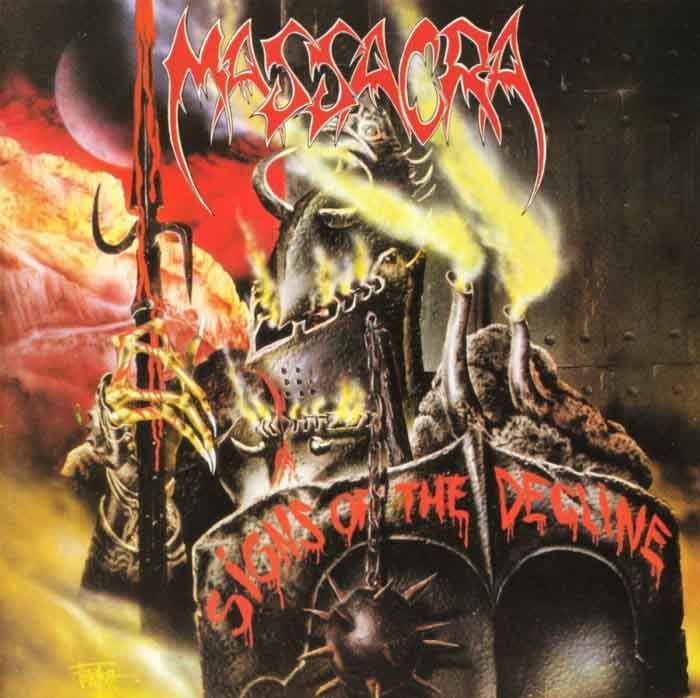
Massacra – Signs of the Decline
As many know, Massacra was one of the best metal bands to ever walk the earth. On Signs of the Decline, however, Massacra chose to go out in the way that most death metal bands would in the years to follow: they imitated their influences in an attempt to reach a wider audience, and the resulting mixture of speed metal, heavy metal, hard rock and death metal held together about as well as four pounds of Taco Bell and a bottle of vodka in the digestive system of the average undergraduate. Many great riffs adorn this album but the space between them has been filled with somewhat generic tropes of the aforementioned metal genres, usually with little thought as to where they should fit in order to communicate anything more than a vague sense of unease and rage. To add insult to injury, the band revisits many of the riff patterns from their earlier albums, but by terminating them in a cross between Metallica and Destruction, Massacra merely manages to mute its own potential. The result has dimensions of Pantera and other bouncy mainstream metal bands trying to coexist with an underground sensibility, which sacrifices the latter and never manages to fully achieve the former, leaving the listener in artistic limbo wondering what is trying to be expressed here. This has the feeling of the product of a band that does not jam together as often, and rushed out a product. If Divine Intervention has a partner, it is this album that shuttles the listener between great hope and greater disappointment.
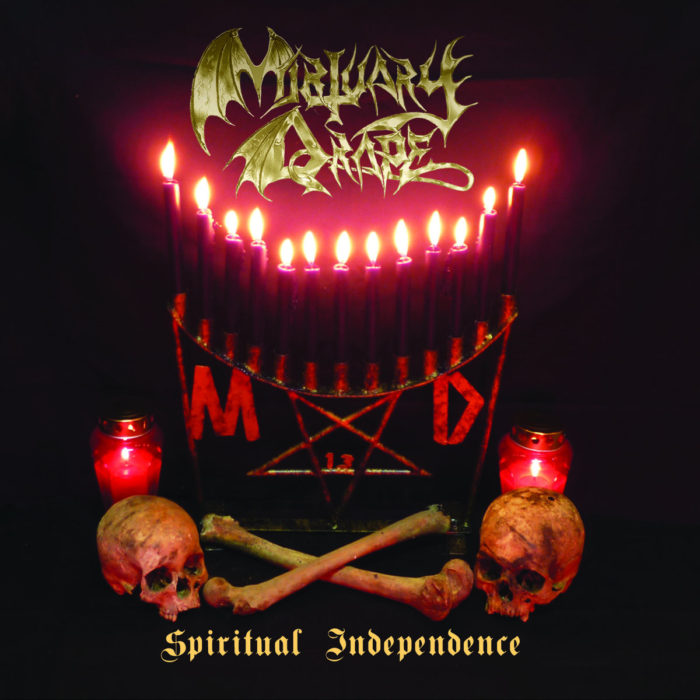
Mortuary Drape – Spiritual Independence
The best way to view this album (and this band) is as a Gothic doom metal version of Mercyful Fate – Don’t Break the Oath. The same wild tempo changes, moody discursive variations, and strong chorus-based rhythms make this album an enjoyable listen. It lacks the dynamic that the melodic vocals add, and riffs are cruder a bit more derivative of the heavy metal years in general, but for each riff that comes off the shelf, something — a lead, a vocal pattern, or another riff — is added which complements the standard and enhances it. For that reason, it makes sense to stop worrying about whether this album is “original” but to realize that it is both invention and emulation tied together by a strong creative vision. Although song structures vary a fair amount, they return to their focus which is the verse-chorus loop with a heavy emphasis on somewhat jaunty death metal styled vocals. The end result is not unpleasant, but is clearly designed for a specific audience, and outside of it may find fewer fans. In particular, it is less intense than the death and death-influenced doom of the 1990s, and has fewer guitar flourishes and harmonies than the retro-classic heavy metal bands, so it really appeals to those who want this particular series of moods, presented with all of the delicious cheese of a Goth band but the charging animal drugged with bad hashish bluntness of garage metal.
Tags: eteritus, Horgkomostropus, Imposition, massacra, mortuary drape, sadistic metal reviews, signs of the decline

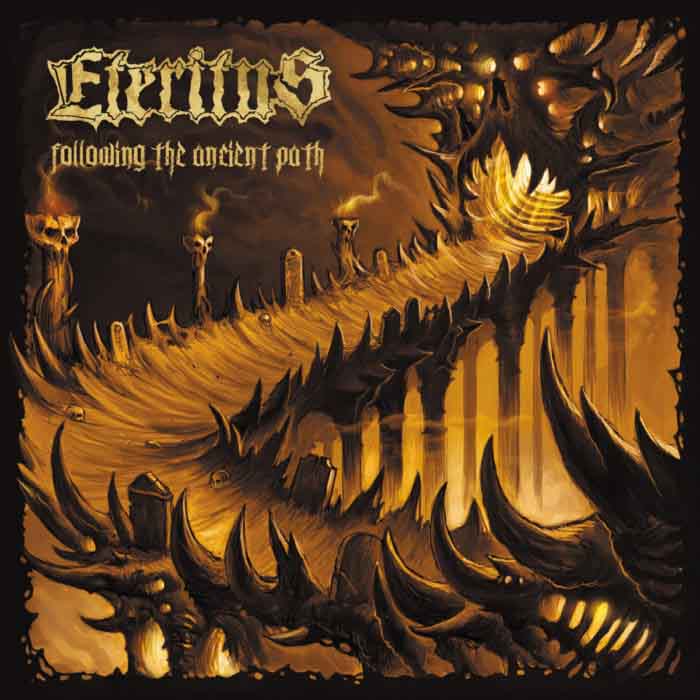
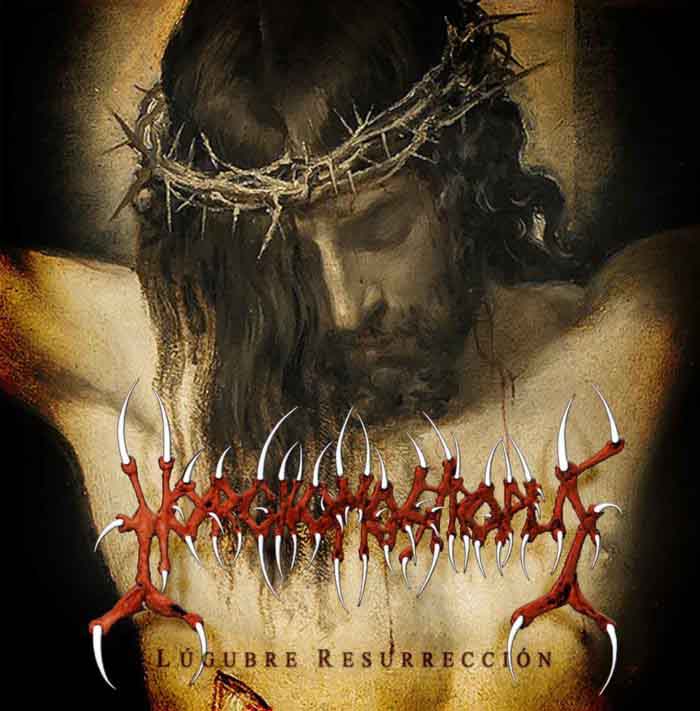
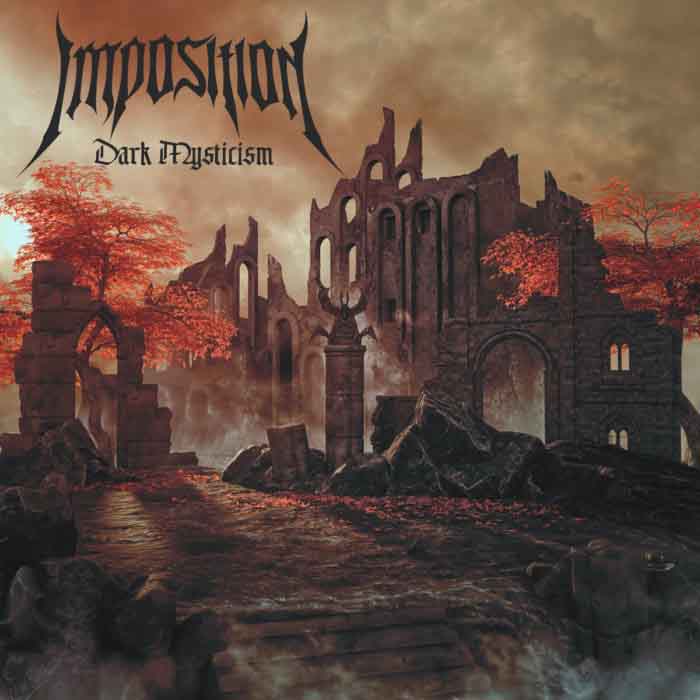



Only 24 years late on that Massacra review
“You invite an attractive woman to your home. She gets naked and hops into your bed.” Already lost me. You know DLA readers can’t relate to this!
More black metal should be directly inspired by Mercyful Fate. GBK is another band like that, and, no matter what the prozak orthodoxy is on them, they’re the crowning jewel of American BM.
It’s not really as easy to pigeonhole what “MF influence” sounds like (besides falsetto) as Slayer or whatever. But what bands who do it well have in common is a certain malign weirdness that’s more than what the riffs sound like.
these read like old SMRs. Bravo.
I reviewed that MD album six months ago. Make like a computer and get with the program! Agree with everything said though. Not surprisingly I’ve barely listened to it this year.
This was the best SMR in awhile. Recently I’ve been listening to Thevetat, Demigod, Kever, who all three I feel have been condemned to obscurity but really, there is death metal snack food for blithering idiots who need lifestyle wallpaper then there’s the realer death metal for the seekers for who life is a journey of the cultivation and harnessing of knowledge and power. Once you’re even a few steps into this realm so much of the modern world seems like a joke best avoided, though you will rot and die you can laugh at those distraught with stupidity who wander helplessly towards oblivion. Let them eat shit, they can have what they think metal is, fuck em all.
I agree GBK is grand, I like MD some too though I don’t listen to them frequently. I’ve been listening to some Winter, Immolation, Purtenance, and Repugnant who sound and play great but can’t put a decent song together, it’s more like an impression of black thrash than the actual thing, which is a shame because they sound awesome, Merciless is still better, blah.
Purtenence is cool and still gets occasional plays out of me though they also have some difficulty in making their songs coherent. I am a sucker for the Finnish death metal, though. Mediocre Finnish DM is still more interesting than pretty-good Swedish or American DM.
I also play that Kever EP occasionally, it is not bad at all and will certainly not fall into obscurity in my collection.
Foresomething: This is about some music I like. I’m considerably more tolerant in this respect than DMU. I expect a CD to be good for listening to it (always entirely) once or twice a day for about a week. It’s usually supposed to provide my mind with something it can engage itself with during more mundane tasks, eg, dish washing or cleaning.
This week:
https://darkdescentrecords.bandcamp.com/album/remnants-of-expansion
[also available directly from the band via bigcartel]
That’s the 2nd album of 4 piece (dr/ b + voc, g, g + voc) Finnish doom/ death (death/ doom?) band. There’s a pretty generic ‘Brett Stevens’ review of the 1st which still mostly applies here (“What is says in the label, so, if you like that …”). Five tracks, only one of them below five minutes and the first about 11. The two first tracks could be regarded as a two-part track (similar motif), the 3rd an instrumental bridge, and the remaining two being a little more death than the first two.
The rhythm is universally set by the guitars which mostly take the form of a fairly simple lead melody in some non-major, vaguely greek-sounding, key, accompanied and emphasized by chords of the second guitar. The first track has a distinct canon-style towards the end with the lead being ahead of the rhythm by about a quarter note. They move at about the same pace in the second, with the rhythm guitar adding harmonic, distorted multi-notes at the accentuated parts of the melody. The third track starts with a short intro similar to the first-track-intro, followed by some two-guitar chord playing and an atmospherically reverbed background. This leads to a lead motif with increasing levels of accompanying chords and a moving upwards and away fadeout at the end. There’s a “Black Magic Women” (that’s a Fleetwood Mac/ Peter Green song) sound in the middle.
The 4th track begins with a simple riff which gradually develops into a melody. This is held together by the rhythm guitar with the lead being slightly ahead of it and the drums chiming in a bit behind. This is followed by an alternation of blasting sections with more doomy ones, moves to a more unhasty lead melody plus accompanyment and terminates in another blast. The final has a doomy start, both guitars again being slightly displaced wrt each other, goes through a passage of offsetted chord playing leading into another blast section.
Throughout of this, deeply growled vocals server as additional accents. The drumming is attentionworhty as the individual song parts are marked by drum patterns of their own. This is always just an additional instrument in a half-lead position, enhancing what the others play but without ever reducing them to fillers between the beats.
Why am I writing all of this, considering that it’s so woefully inadequate to describe the sonic experience and that it will (at best) cause another “vet” to come out of the woodwork to point out that four different bands in 1643 played four different things which were almost but not completely different from this and – by that time – he was still in a receptive state?
This is pretty good.
“You invite an attractive woman to your home. She gets naked and hops into your bed. You dash off to the kitchen to get some wine.”
Not only can most DMU consumers relate to that, but… you fucked up the order. You put A/C/B. It should be A/B/C. She needs the wine in order to hop into your bed, you seductive motherfucker.
What if the attractive woman happens to have a huge cock?
Then who would need the wine in that scenario?
I think well hung ladies are traditionally Martini drinkers.
Shaken, or stirred?
Stroked.
Everything is so warm. And everything is so bright. Remmeber that my manliness simulation, though subject to Robert’s whims, is this greatest on the planet.